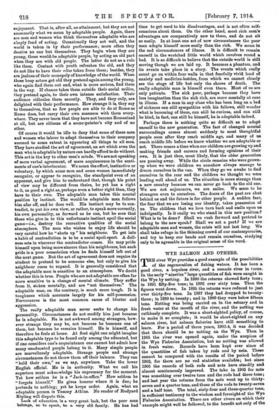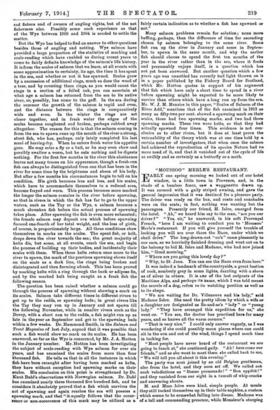WYE SALMON AND OTHERS.
THE river Wye provides a good example of the possibilities of the regeneration of fishing waters. It has been a good river, a hopeless river, and a remade river in turns. In the early " nineties" large quantities of fish were caught in the Wye by netting. In 1890 the returns showed forty tons ; in 1891 fifty-five tons ; in 1892 over sixty tons. Then the figures went down. In 1895 the returns were reduced to just over thirty-five tons. In 1897 they had dropped to twenty- three ; in 1899 to twenty ; and in 1900 they were below fifteen tons. Netting was being carried on in the estuary and in fresh water at the month of the river, and the netting was ruthlessly complete. It was a short-sighted policy, of course, to make it so complete; it would be short-sighted on any salmon river, but salmon fisheries have still something to learn. For a period of three years, 1902.4, it was decided that there should be no netting on the Wye. Then in 1905 the ricer was opened again, under the auspices of the Wye Fisheries Association, but no netting was allowed in fresh water. Records have been kept ever since of the quantities of fish taken by rods and by nets. These cannot be compared with the results of the period before 1902, for there are no rod statistics available; but since 1905 the records of both rods and nets have steadily and almost continuously improved. The take in 1905 for nets was something over twelve tons and the rode had three tons ; and last year the returns from the nets went up to thirty- seven and a quarter tons, and those of the rods to twenty-seven and a half tons. The total, sixty-four and three-quarter tons, is sufficient testimony to the wisdom and foresight of the Wye Fisheries Association. There are other rivers on which their example might well be followed, to the benefit not only of the
rod fishers and of owners of angling rights, but of the net fishermen also. Possibly some such experience as that of the Wye between 1900 and 1904 is needed to settle the matter.
- But the Wye has helped to fincl an answer to other questions besides those of angling and netting. Wye salmon have provided a large proportion of the statistics of marking and scale-reading which have enabled us during recent years to come to fairly definite knowledge of the salmon's life history. It is from the scales of salmon that we learn, at all events with some approximation to certainty, its age, the time it has spent in the sea, and whether or not it has spawned. Scales grow by a succession of additional rings, much as does the wood of a tree, and by counting these rings, as you would count the rings in a section of a felled oak, you can ascertain at what age a salmon has returned from the sea to its native liver, or, possibly, has come to the gaff. In the sea during the summer the growth of the salmon is rapid and even, and the distance between the rings is comparatively wide and even. In the winter the rings are set closer together, and in fresh water the edges of the scales become roughened and broken, perhaps rubbed away altogether. The reason for this is that the salmon coming in from the sea to spawn runs up the mouth of the river a strong, stout fish, who has, perhaps, only lately completed his last meal of herring-fry. When he enters fresh water his appetite goes. He may seize a fly or a bait, or he may even chew and possibly swallow a worm, but he eats nothing and he digests nothing. For the first few months in the liver this abstinence leaves not many traces on his appearance, though a fresh-run fish can always be distinguished from one that has been in the river for some time by the brightness and sheen of his body. But after a few months his circumstances begin to tell on his condition. His girth becomes less and less, and his scales, which have to accommodate themselves to a reduced area, become frayed and worn. This process becomes more marked the longer the salmon remains in the river before spawning, so that in rivers in which the fish has far to go to the upper waters, such as the Tay or the Wye, a salmon becomes a much shrunken fish before the actual process of spawning takes place. After spawning the fish is even more exhausted; the female salmon may deposit ova which before spawning formed one-fourth of her total weight, and the loss of girth, of course, is proportionately large. All these conditions show themselves in marks on the scales. The spent fish, or kelt, drops down the river towards the sea; the great majority of kelts die, but some, at all events, reach the sea, and begin the process of building up their bodies, and incidentally their scales with them. When these kelts return once more to the river to spawn, the mark of the previous spawning shows itself on the scale as a dark line, the rings being broken and disintegrated and then forming afresh. This has been proved by marking kelts with a ring through the bank or adipose fin, and by the marked kelt being caught as a fresh fish the following season.
The question has been raised whether a salmon could go through the process of spawning without showing a mark on its scales. Salmon take different times in different rivers to get up to the reads, or spawning beds ; in great rivers like the Tay they may run up in January and not spawn till the following November, while in smaller rivers such as the Dovey, with a short run to the redde, a fish might run up as late in theyear as September and get to the spawning beds within a few weeks. Dr. Hammond Smith, in the Salmon and Trout Magazine of last July, argued that it was possible that such a fish would show no mark on its scales. He has been answered, so far as the Wye is concerned, by Mr. J. A. Hutton in the January number. Mr. Hutton has been investigating the subject of scale-reading with Wye salmon for over six yeare, and has examined the scales from more than four thousand fish. He tells us that in all the instances in which fish have been recaught after having been marked as kelta, they have without exception had spawning marks on their stales. His conclusion on this point is strengthened by Dr. Runt Dahl's observations with Norwegian salmon. Dr. Dahl has examined nearly three thousand five hundred fish, and he considers it absolutely proved that a fish which survives the act of spawning and again reaches the sea will possess a spawning mark, and that " it equally follows that the occur- rence or non-oocurrence of this mark may be utilized as a fairly certain indication as to whether a fish has spawned or not."
Many salmon problems remain for solution; none more baffling, perhaps, than the difference of time for ascending chosen by salmon belonging to the same river. Some fish run up the river in January and some in Septem- ber, to spawn in the same month, and why the earlier fish should choose to spend the first ten months of the year in the river rather than in the sea, where it feeds and presumably enjoys itself, is a question which has not yet been answered. But another question which a few years ago was unsettled has recently had light thrown on it in a paper published by the Fishery Board for Scotland, which Mr. Hutton quotes in support of his argument that fish which have only a short time to spend in a ricer before spawning might be expected to be more likely to survive than others which have a long run up from the sea. Mr. W. J. M. Menzies in this paper, " Scales of Salmon of the River Add," mentions that of the fish examined in 1913 as many as fifty-two per cent. showed a spawning mark on their scales, three had two spawning marks, and two had three spawning marks. These two were belts, so that they had actually spawned four times. This evidence is not con- clusive as to other rivers, but it does at least prove the untenability of the theory which was at one time held by a certain number of investigators, that when once the salmon had achieved the reproduction of its species Nature had no more need of it, and that it vanished out of the cycle of life as swiftly and as certainly as a butterfly or a moth.











































 Previous page
Previous page